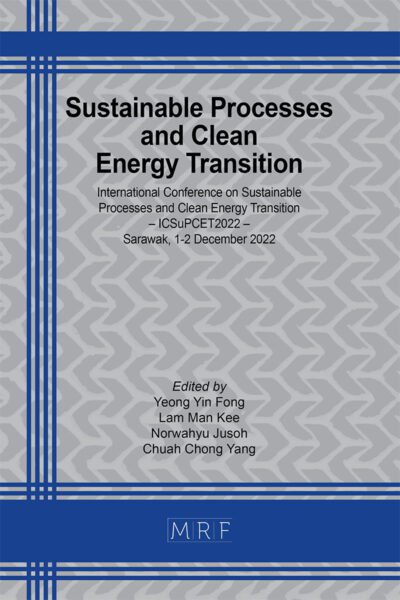Quantification and mitigation of carbon footprint in petroleum refinery process through simulation software
MUHAMMAD Nabil Fikri bin Shariffuddin, NABILA Farhana binti Jamaludin, MUHAMMAD Fairis bin Hadipornama
Abstract. Petroleum refineries play a crucial role in producing various petroleum products through processes such as distillation, redistillation, cracking, and reforming. As the second-largest consumer of energy among industries, petroleum refineries significantly contribute to GHG emissions, particularly through combustion-related sources like process heaters and boilers. Therefore, it is crucial to adopt sustainable approaches to control and reduce these emissions. Simulation software like Aspen Plus/Symmetry can be utilized to quantify greenhouse gas emissions in petroleum refineries. This software allows for the selection of appropriate utility sources and energy strategies, ensuring compliance with sustainability regulations and facilitating the improvement of the refinery’s carbon footprint in the future. Hence, this paper focuses to the quantification and mitigation of carbon footprints in petroleum refinery processes, with specific emphasis on the application of Aspen HYSYS. The results show 9.12 percentage differences in comparison with the manual calculation. A several mitigation options has been considered for different case and the differences in terms of GHG emissions has been analysed.
Keywords
Petroleum Refinery, Carbon Quantification, Simulation Software, Mitigation Cases
Published online 4/25/2025, 8 pages
Copyright © 2025 by the author(s)
Published under license by Materials Research Forum LLC., Millersville PA, USA
Citation: MUHAMMAD Nabil Fikri bin Shariffuddin, NABILA Farhana binti Jamaludin, MUHAMMAD Fairis bin Hadipornama, Quantification and mitigation of carbon footprint in petroleum refinery process through simulation software, Materials Research Proceedings, Vol. 53, pp 409-416, 2025
DOI: https://doi.org/10.21741/9781644903575-41
The article was published as article 41 of the book Decarbonization Technology
![]() Content from this work may be used under the terms of the Creative Commons Attribution 3.0 license. Any further distribution of this work must maintain attribution to the author(s) and the title of the work, journal citation and DOI.
Content from this work may be used under the terms of the Creative Commons Attribution 3.0 license. Any further distribution of this work must maintain attribution to the author(s) and the title of the work, journal citation and DOI.
References
[1] Bowen, F., & Wittneben, B. (2011). Carbon accounting. Accounting, Auditing & Accountability Journal, 24(8), 1022–1036. https://doi.org/10.1108/09513571111184742.
[2] Khalaf, A. (2018). Steady State Simulation of Basrah crude oil refinery distillation unit using Aspen Hysys. Thi-Qar University Journal for Engineering Sciences. https://doi.org/10.31663/tqujes.9.2.312(2018)
[3] Leontief, W.W. (1972) “Air Pollution and the Economic Structure Empirical Results of Input-Output Computations,” in Input Output Economics 2nd ed., Oxford University Press, New York, 1986, pp.273-293.
[4] Leontief, W.W. (1970) “Environmental Repercussions and the Economic Structure: An Input-Output Approach,” Review of Economics and Statistics, Vol.52, No.3, pp.262-271.
[5] Madugula, A. C., Sachde, D., Hovorka, S. D., Meckel, T. A., & Benson, T. J. (2021). Estimation of CO₂ emissions from petroleum refineries based on the total operable capacity for carbon capture applications. Chemical Engineering Journal Advances, 8, 100162. https://doi.org/10.1016/j.ceja.2021.100162
[6] Moro, L.F.L., Zanin, A.C. and Pinto, J.M. (1998) ‘A planning model for refinery diesel production’, Computers and Chemical Engineering, Vol. 22, pp.1039–1042.
[7] M. Wilkinson, J. Boden, T. Gilmartin, C. Ward, D. Cross, R. Allam, N. Ivens, CO2 capture from oil refinery process heaters through oxyfuel combustion, in: Proceedings of the Greenhouse Gas Control Technologies 6th International Conference, Elsevier, 2003, pp. 69–74, https://doi.org/10.1016/b978-008044276- 1/50012-x.
[8] Neiro, S.M.S. and Pinto, J.M. (2005) ‘Multiperiod optimization for production planning of petroleum refineries’, Chemical Engineering Communications, Vol. 192, pp.62–88.
[9] Pinto, J.M. and Moro, L.F.L. (2000) ‘A planning model for petroleum refineries’, Brazilian Journal of Chemical Engineering, Vol. 17, Nos. 4–7, pp.575–586.
[10] Smith, J. A., Johnson, M. B., Brown, C. D., & White, E. F. (2010). Simulation-Based Carbon Emission Quantification in Petroleum Refinery Processes: A Review of Methodologies and Challenges. Journal of Environmental Engineering, 42(3), 123-145.
[11] Sotelo, D., Favela-Contreras, A., Lozoya, C., Beltran-Carbajal, F., Dieck-Assad, G., & Sotelo, C. (2019). Dynamic simulation of a crude oil distillation plant using AspenHYSYS®. International Journal of Simulation Modelling, 18(2), 229–241. https://doi.org/10.2507/ijsimm18(2)465
[12] U.S. DOE (Department of Energy). 2007. Energy and Environmental Profile of the U.S. Petroleum Refining Industry. Prepared by Energetics, Inc., Columbia, MD. November 2007.
[13] Yousuo, Digieneni & Obuebite, Ann Amalate. (2023). The Determination of the Quantity of CO 2 Produced in a Local Ethanol Plant using Aspen HYSYS Software. 7. 41.
[14] Zhang, N., and Zhu, X.X. (2000) ‘A novel modelling and decomposition strategy for overall refinery optimisation’, Computers and Chemical Engineering, Vol. 24, pp.1543–1548.
[15] Ziółkowski, P., Madejski, P., Amiri, M., Kuś, T., Stasiak, K., Subramanian, N., PawlakKruczek, H., & Mikielewicz, D. (2021). Thermodynamic analysis of negative CO2 emission power plant using Aspen Plus, Aspen Hysys, and Ebsilon Software. Energies, 14(19), 6304. https://doi.org/10.3390/en14196304












